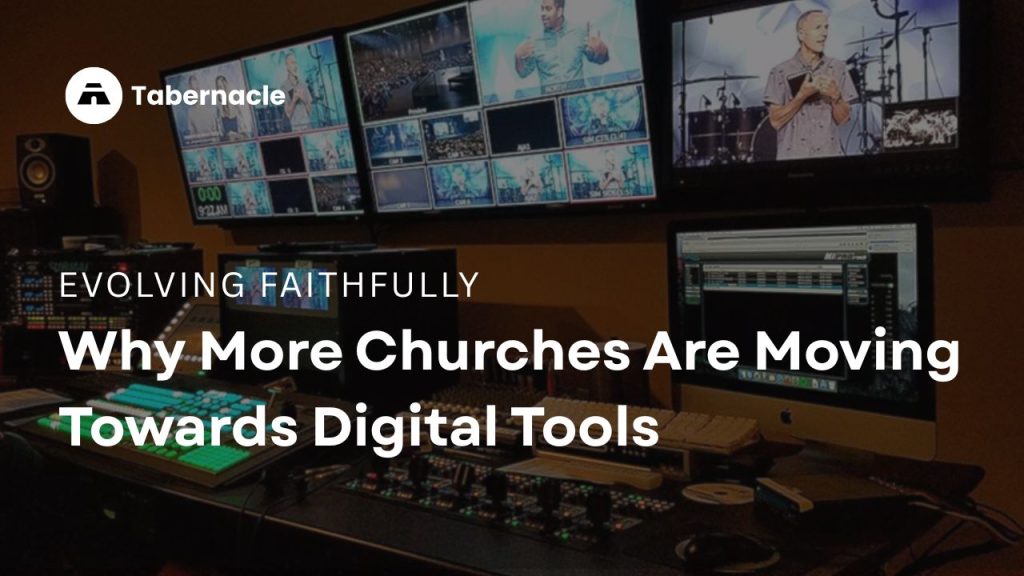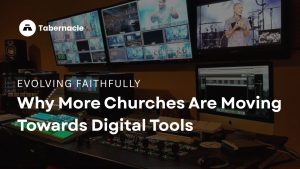Why More Churches Are Moving Towards Digital Tools
Churches in Northeast India are embracing digital transformation using livestreams, apps, and cloud tools to connect communities, manage ministries, and extend their reach beyond physical boundaries.
-
Tabernacle

The Digital Shift in Christian Communities
In recent years, one of the most visible shifts in Christian communities across the world has been the adoption of digital tools. From livestreaming Sunday services to hosting Bible studies over YouTube, the church is embracing technology at a pace we have not seen before. This is not just a Western trend. In Asia, from the megachurches of Singapore and South Korea to smaller, rural congregations in Northeast India, digital transformation has become both a necessity and an opportunity.
Global Momentum Towards Digital Church
Globally, the pandemic accelerated what was already in motion. Many churches had been experimenting with websites, social media, and mobile apps, but lockdowns forced even the most traditional congregations online. What began as a survival strategy has now evolved into a permanent feature of church life.
In South Korea, for example, churches are using sophisticated mobile platforms for sermon archives, small group coordination, and even online tithing. In the Philippines, digital evangelism through YouTube and Facebook has created new avenues to reach younger generations who might never walk into a church building. Singapore’s churches are leaders in hybrid models, where in-person worship is complemented by polished livestreams that reach congregants across the globe.
The lesson is clear: technology is not replacing the church, but it is expanding its reach.
Why Digital Transformation Matters in Northeast India
The churches of Nagaland and the wider Northeast are deeply rooted in community life. Sunday services, youth fellowships, and women’s prayer groups are woven into the social fabric. Yet the region also faces unique challenges:
- Geographical isolation: Many villages are remote, and road conditions or weather often prevent regular travel.
- Diaspora connections: Thousands of young Nagas and Northeasterners live in Indian metros or abroad for studies and work, longing to remain connected with home churches.
- Generational shifts: Young people are digital natives, consuming most of their content on Instagram, YouTube, and messaging apps like Whatsapp, Telegram and Signal.
Here, digital tools provide not only convenience but also connection. During the pandemic, many Naga churches quickly turned to Facebook Live or YouTube to stream services. WhatsApp became a hub for prayer chains and Bible reading groups. Some churches even started digital newsletters or podcasts to keep the community engaged.
What might have felt temporary has now become part of regular ministry. Congregants expect livestreams if they cannot attend in person. Youth fellowships are just as likely to host a Zoom discussion as a physical gathering. Churches are beginning to see that digital presence is not secondary, but central to ministry in a connected world.
Administrative Advantages of Digital Tools
Beyond worship and outreach, many churches are also improving their internal administration through digital tools. Church management once plagued by scattered records, hardcopy registers and manual data entry is being transformed by cloud-based systems and specialized church management software.
Think of it like this: if all your church records are on one office computer, only that computer can access them. Using a cloud-based system is like keeping them in an online “filing cabinet” — accessible from any phone or computer with internet.
These tools help churches:
- Organize events and track members easily
- Manage donations safely online
- Collect feedback from the congregation to improve ministry
Adoption is uneven, especially among smaller churches and leaders less familiar with technology, but training programs for staff and volunteers are becoming increasingly common.
Opportunities Digital Tools Unlock
Wider Reach and Inclusion
A sermon delivered in Kohima can now be heard in Delhi, London, or New York by diaspora members. Small churches with limited physical capacity suddenly have a global stage.
Language and Culture Preservation
Digital tools also allow churches in the Northeast to record, archive, and share sermons in indigenous languages. This becomes a cultural asset for future generations.
Youth Engagement
For many young people, church content on Instagram or YouTube is their first touchpoint with faith outside Sunday worship. Memes, reels, and podcasts may seem informal, but they are powerful bridges to meaningful discipleship.
Flexibility in Discipleship
Online Bible studies, app-based devotionals, or prayer groups on Telegram make it easier for members to remain engaged despite busy schedules or migration to other cities.
Digital Giving and Transparency
Churches across Asia are adopting digital payment methods, which not only make giving easier for members but also allow for greater accountability and record-keeping.
Challenges Churches Must Navigate
Of course, going digital is not without challenges. Many rural areas of Northeast India still face weak internet connectivity, making livestreams unreliable. There are also generational gaps: while youth adapt quickly, older members may struggle with technology. Moreover, churches must think carefully about online security, data privacy, and the dangers of misinformation.
Another concern is theological: will digital tools encourage passive spectatorship rather than active discipleship? Churches must ensure that online platforms complement, rather than replace, embodied community.
Learning from Asia, Shaping Our Own Path
The Northeast Indian churches have much to learn from churches in Asia that are years ahead in digital adoption. For example, Singaporean churches have developed apps that allow members to register for services, join cell groups, or request pastoral care seamlessly, Korean churches invest in high-quality livestream production, Filipino pastors are using TikTok/Instagram to share short, daily devotionals with millions of viewers.
Yet, the Northeast does not need to copy-paste. Our context is unique. A digital ministry here might prioritize vernacular content, community-based WhatsApp groups, or affordable and low-bandwidth solutions. Even simple tools, if used creatively, can be powerful. A short Facebook post in a local dialect may minister more deeply than a polished but impersonal video.
In addition to outreach and discipleship, churches in the Northeast are also exploring digital solutions for internal administration. Cloud-based church management systems help streamline membership records, finances, and event planning, making day-to-day operations more efficient.
The Way Forward: Embracing Technology with Purpose
The church has always adapted to new mediums, from the printing press to the radio, television, and now the smartphone. Each tool, when used wisely, can serve the mission of the church. The shift we see today is not a threat to tradition but a continuation of the church’s long history of innovation for the sake of the Gospel.
For the churches in the Northeast, the question is no longer whether to embrace digital tools, but how to do so thoughtfully and sustainably. It means equipping pastors and volunteers with basic digital skills, investing in affordable technologies, and cultivating a theology that sees technology as a gift rather than a distraction.
Going forward, embracing digital tools for administration, such as online databases for member records, finance tracking, and event coordination will be as important as using technology for worship and outreach.
In an age when people, both young and old, live as much online as offline, the church is called to be present in both spaces. Digital tools are not about chasing trends. They are about fulfilling the timeless mission of the church: to gather, disciple, and send God’s people into the world.
Our Latest Insights on Church Management & Technology.
Get Your Updates Instantly.

Churches in Northeast India are turning to digital tools, from livestreams to apps, to strengthen community connections, engage young congregants and improve church administration. This shift is transforming worship, outreach, and administration in ways that were once unimaginable.

Churches in Northeast India are turning to digital tools, from livestreams to apps, to strengthen community connections, engage young congregants and improve church administration. This shift is transforming worship, outreach, and administration in ways that were once unimaginable.

In catering to the youth of this generation, the church must bear in mind that this generation possesses information at their fingertips in unprecedented ways.